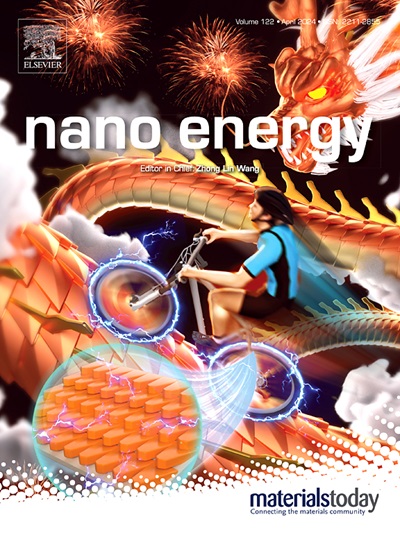Mimosa-inspired tribo-electromagnetic nanogenerator for adaptive wind energy harvesting and intelligent wind monitoring
IF 16.8
1区 材料科学
Q1 CHEMISTRY, PHYSICAL
引用次数: 0
Abstract
Efficient low-speed wind energy harvesting and wind speed monitoring in natural environments are hot topics in nanogenerator research. The latest designs suffer from some limitations such as high start-up wind speed, low output, short lifespan, and single functionality. Here, an adaptive tribo-electromagnetic nanogenerator inspired by Mimosa for intelligent wind speed sensing and energy harvesting is reported. The flexible-PTFE enables stepless switching between non-contact and soft-contact modes with gradually increasing area based on the variation of centrifugal force. Curved PTFE acts as both a friction layer and an adaptive actuator, reducing energy loss and material wear. Through systematic simulation and experimental optimization, the nanogenerator demonstrates an ultralow start-up wind speed of 0.5 m/s while achieving a remarkable peak power output of 182.3 mW at 10 m/s. A multifunctional power management circuit is developed, and the applications of the nanogenerator in traffic warning and smart home are demonstrated. Also, an integrated system for real-time wind speed sensing and energy harvesting has been developed. Laboratory and in-situ wind tests are conducted to evaluate and validate the system. This work provides a new approach to real-time wind speed monitoring and energy harvesting deployments for challenging low wind speeds, high efficiency, and long lifespan requirements.

含羞草启发的摩擦电磁纳米发电机,用于自适应风能收集和智能风监测
自然环境下高效的低速风能采集和风速监测是纳米发电机研究的热点。最新的设计受到一些限制,如高启动风速,低输出,短寿命,单一功能。本文报道了一种受含羞草启发的自适应摩擦电磁纳米发电机,用于智能风速传感和能量收集。柔性聚四氟乙烯能够在非接触和软接触模式之间无级切换,并根据离心力的变化逐渐增加面积。弯曲的聚四氟乙烯作为摩擦层和自适应致动器,减少能量损失和材料磨损。通过系统仿真和实验优化,该纳米发电机在启动风速为0.5 m/s的情况下,以10 m/s的速度实现了182.3 mW的峰值输出。研制了一种多功能电源管理电路,并演示了纳米发电机在交通预警和智能家居中的应用。此外,还开发了一个实时风速传感和能量收集的集成系统。进行了实验室和现场风测试来评估和验证系统。这项工作为实时风速监测和能量收集部署提供了新的方法,以应对低风速、高效率和长寿命的要求。
本文章由计算机程序翻译,如有差异,请以英文原文为准。
求助全文
约1分钟内获得全文
求助全文
来源期刊

Nano Energy
CHEMISTRY, PHYSICAL-NANOSCIENCE & NANOTECHNOLOGY
CiteScore
30.30
自引率
7.40%
发文量
1207
审稿时长
23 days
期刊介绍:
Nano Energy is a multidisciplinary, rapid-publication forum of original peer-reviewed contributions on the science and engineering of nanomaterials and nanodevices used in all forms of energy harvesting, conversion, storage, utilization and policy. Through its mixture of articles, reviews, communications, research news, and information on key developments, Nano Energy provides a comprehensive coverage of this exciting and dynamic field which joins nanoscience and nanotechnology with energy science. The journal is relevant to all those who are interested in nanomaterials solutions to the energy problem.
Nano Energy publishes original experimental and theoretical research on all aspects of energy-related research which utilizes nanomaterials and nanotechnology. Manuscripts of four types are considered: review articles which inform readers of the latest research and advances in energy science; rapid communications which feature exciting research breakthroughs in the field; full-length articles which report comprehensive research developments; and news and opinions which comment on topical issues or express views on the developments in related fields.
 求助内容:
求助内容: 应助结果提醒方式:
应助结果提醒方式:


